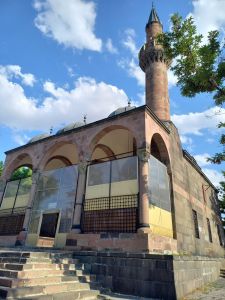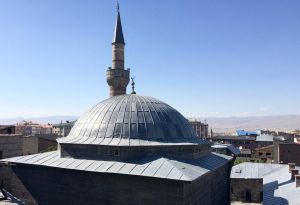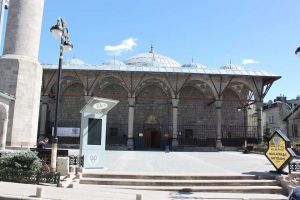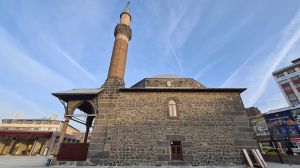The Mosque of Ibrahim Pasha
The Mosque of Ibrahim Pasha
The mosque was built in the late 16th century by Sadrazam Ibrahim Pasha. It was built by Sadrazam Ibrahim Pasha at the end of the century. Ibrahim Pasha, Sultan Suleiman the Magnificent and III. He was a statesman who held important positions during the Murad period.
Architectural features of the Ibrahim Pasha Mosque
The architect of the mosque is Mimar Sinan. Completed in 1570, the mosque is one of the last works of architect Sinan. The architectural style of the mosque is in line with the general style of architect Sinan and has a plan similar to that of the Selimiye Mosque.
The mosque draws attention with its square-shaped courtyard and recesses. The main structure is covered with a large dome and side domes. In the interior, there is a large altar, minbar and mahfils that bear the characteristics of the architecture of the Ottoman period. In addition, the Chinese, pencilwork and calligraphy on the walls of the mosque are among the details that attract visitors.
The exterior of the mosque is quite simple. Above the main entrance gate is the tombstone of Ibrahim Pasha and the date of construction of the mosque. In the northeast corner of the mosque is the tomb of Ibrahim Pasha.
Today, the Ibrahim Pasha Mosque is a popular tourist attraction visited by both domestic and foreign tourists. Moreover, the mosque is still a regular place of worship.
How to get to the Ibrahim Pasha Mosque
Erzurum is also home to the Ibrahim Pasha Mosque. The mosque is located in Kale Mahallesi. You can use the following methods to reach the mosque:
Public transportation: Intercity buses operate frequently in Erzurum. You can find a bus that you can get off at Kale Mahallesi to go to the Ibrahim Pasha Mosque.
Taxi: There is a taxi service in Erzurum and you can take a taxi to the Ibrahim Pasha Mosque. You can tell the taxi driver where you can find the mosque.
On foot: You can also walk to the Ibrahim Pasha Mosque in Erzurum. Since the mosque is located in the city center, it is quite easy to reach it on foot. However, since Erzurum is a cold city, it is recommended that you wear warm clothes when hiking, especially in winter.
What is the Ibrahim Pasha Mosque?
There are many traditional restaurants and restaurants around Erzurum Ibrahim Pasha Mosque. These restaurants offer flavours typical of Erzurum. Some suggestions are:
Cağ Kebabı: Cağ Kebabı, a famous dish of Erzurum, is a kebab made from lamb meat and is usually served with lavash bread. There are many Cağ Kebab restaurants around the Ibrahim Pasha Mosque.
Borani: Borani is a dish made with eggplant and turmeric. It is usually topped with yogurt and served hot.
Ayran Aşığı: Ayran Aşığı is a soup typical of Erzurum. This soup, made with yogurt, flour, rice, salt, and water, is usually flavored with spices and served with butter and red pepper.
Piti: Piti is a dish made with lamb and peas. It is usually seasoned with spices and served with butter and garlic yogurt on top.
There are many restaurants around the Ibrahim Pasha Mosque where you can taste these delicious dishes. In addition, street vendors in the area also offer Erzurum's street delicacies.
Places to visit near the Ibrahim Pasha Mosque
There are many historical and tourist attractions near the Ibrahim Pasha Mosque. Here are some places you can visit:
Yakutia Madrasah: Yakutia Madrasah, located in the historical center of Erzurum, is an educational center built in the 14th century. It's an educational center built in the 19th century. The madrasa, a fine example of Seljuk architecture, is now used as a museum.
Erzurum Castle: Erzurum Castle, located in the center of the city, was built by the Byzantine Empire in the 5th century. It was built by the Byzantine Empire in the 11th century. Inside the castle, there are also historical mosques and baths dating back to the Ottoman Empire.
Double Minaret Madrasa: The Double Minaret Madrasa, which became the symbol of Erzurum, was built in the 13th century. It was built in the 19th century. The madrasa, a fine example of Seljuk architecture, can still be visited today.
Lala Mustafa Pasha Mosque: Lala Mustafa Pasha Mosque, one of the historical mosques of Erzurum, was built in the 16th century. It was built in the 19th century. The mosque, a fine example of Ottoman-era architecture, is within walking distance of the Caferiye Mosque.
Erzurum Archaeological Museum: The Erzurum Archaeological Museum, located in the city center, exhibits historical and archaeological artifacts from the region. The museum contains artifacts from the historical periods of Erzurum and its surroundings.
Narman Fairy Towers: The Narman Fairy Towers, located about 50 kilometers from Erzurum, are one of the natural beauties of the region. The fairy chimneys, formed as a result of a historic volcanic eruption, attract visitors.






Değerlendirmeler